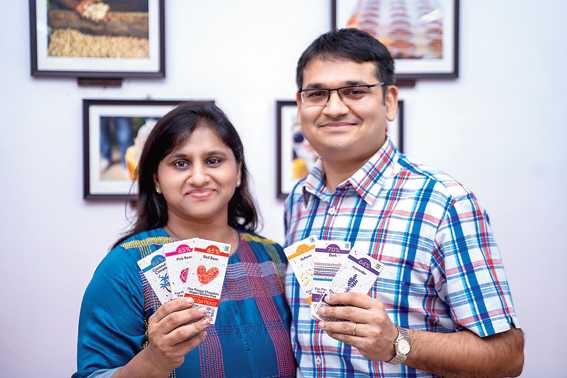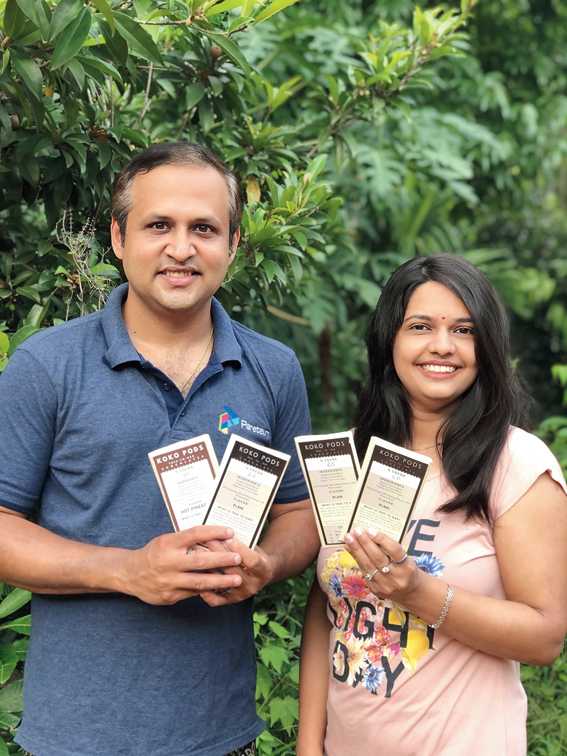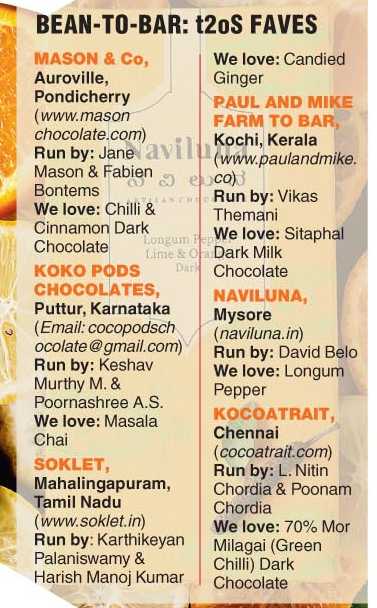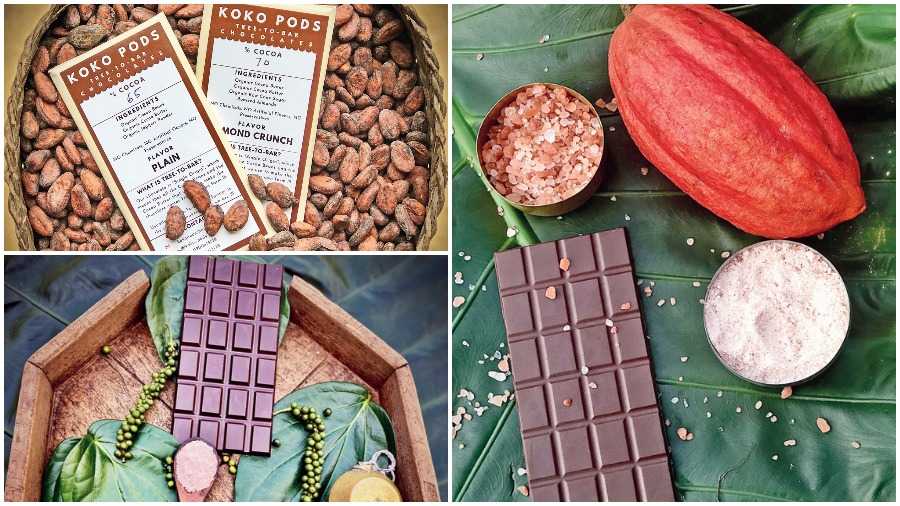The yummy chocolate bar that you have in your fridge, is that a ‘real’ one? Well, chances are that it’s not, says India’s new-age chocolate guru L. Nitin Chordia, especially if it’s from a mass-producing big corporate brand. No, it’s home-made, you declare? Aha, even then “real chocolate could be a far cry”!
Because, only bean-to-bar is the answer to one’s quest for real, pure, local, and sustainable chocolate. And today, the Indian consumer is lucky to have a handful of these small-scale chocolate makers who are walking the extra mile to bring a mindboggling variety of artisanal and purely desi versions of the real Indian chocolate.

Nitin Chordia is India’s new chocolate guru and, along with wife Poonam, is the brain behind bean-to-bar brand Kocoatrait
What’s bean-to-bar?
When you pluck a cocoa pod from the Theobroma Cacao plant, ferment the beans with its pulp from within, dry, roast and deshell them to get small broken pieces called cocoa nibs, grind the nibs into a buttery paste, temper it and set it in a mould with or without a sweetener — what you get is chocolate. And when this entire process happens with full quality control — chocolate makers personally ensure which beans from which trees of which farm are used, they sort every bean by hand and choose only the best, avoid chemicals in the process, ensure that the harvesting conforms to the best sustainable practices and the profits benefit the farmers directly — you get bean-to-bar chocolate, the real thing.
How is it different from big brand bars?
For most of the mass-market chocolates, the cocoa beans are extensively treated with chemicals, stripping them of their intricate notes and flavours. Plus, the processing separates the fat content of the cocoa beans, called cocoa butter, which is sold to cosmetics and pharma companies. “Devoid of the cocoa butter, what is left is only the dry cocoa powder, which then is mixed with emulsifiers, milk solids, sugar, artificial chocolate flavours, other additives and, maybe, a little cocoa butter to create a homogenised compound we buy in the name of chocolate,” explains Chordia, who has been educating both cocoa farmers and chocolate makers as well as discerning consumers about the bean-to-bar concept for the past six years through his centre Cocoashala in Chennai.
Cocoa butter matters
Cocoa butter is the fat in cocoa beans. Around 50-60 per cent of the cocoa nibs is cocoa butter. “Chocolate needs just two ingredients — cocoa beans and sugar/jaggery. Since a cocoa bean itself contains cocoa butter, emulsifiers are not much needed in chocolates. Cocoa butter is the reason that chocolate literally melts in your mouth. Also, it lends its own flavours to the final tasting experience,” explains Keshav Murthy M, the man behind Koko Pods Chocolates from Karnataka.

Keshav Murthy M. and Poornashree A.S. of Karnataka are the couple behind Koko Pods Chocolates and have created flavours like Pan Delight (left) and Delicious Salt
What about home-made chocolates?
If you’re making chocolate at home, it’s home-made. But if you are buying cocoa from the market, then it’s the same cocoa powder that the industrial giants are packaging for you after extracting the cocoa butter. So, while you may put all your love in the chocolate making, it still doesn’t make the cut for the ‘real’ tag. “Also, beans of different qualities from different sources are mixed up and homogenised at the big brand manufacturing units,” says Chordia, the country’s first chocolate taster certified by International Institute of Chocolate and Cacao Tasting.
But even big brands offer bitter dark chocolate…
They do, but most of them still have very little cocoa butter. And they are processed chemically, with lots of additives and emulsifiers. Plus, most have milk as an ingredient. “In fact, most of the commercial chocolates in India have milk in them. Dark chocolate is known to be good for health. Cacao has lots of antioxidants but the body’s ability to absorb antioxidants is almost nullified when milk protein is added. The milk is added to increase the flavour profile, make the chocolates creamier and also to mimic the taste experience of Indians used to milk and milk-based mithais,” says Chordia.
Does bean-to-bar taste different?
It’s like a fine Scotch. Or fine wine. Products that are heavily influenced by the terroir, post-harvest processing and other factors. One experiences a plethora of flavour profiles from bean-to-bar chocolates. “In fact, chocolate contains double the flavour compounds than wine. Hence, there’s a significant impact of soil, weather, environment and bio-diversity on the flavour of the cacao,” explains David Belo of Naviluna artisan chocolates.
Besides, the processing — the way the beans are fermented and dried — can make or break a chocolate experience.
Fine cocoa has its own flavour. “We don’t need to use additives or artificial flavours. For example, my 70% Classic Chocolate has an afternote of honey, but I don’t add honey. The flavour comes naturally, because of the genetics plus the terroir and the fermentation process,” says Rushdah Humaira, a bean-to-bar maker from Bengal who launched her brand Rushk last year.
While experimenting with the fermentation, Keshav of Koko Pods Chocolate once tried adding Hippli pepper (a local south Indian variety) during the process. “I was delighted to find that the flavour came through really well in the end product,” he says.
The desi quotient
First, all of these chocolate makers use cocoa beans sourced from Indian farms. Nothing is imported. South India is where the bulk of Indian cacao grows. Hence, it’s #EatingLocal done right.
Next, the equipment used is very small-scale and mostly improvised locally available machines. The humble stone wet-grinder used to make idli batter is one. It’s a magic maker in the artisanal chocolate industry. All the beans are ground in these slightly tweaked wet-grinders!
Finally, the desi twist to bean-to-bar chocolates comes in the form of infusions and inclusions of a range of India-specific fruits and nuts, herbs and spices et al.
“India has always boasted of some of the world’s most flavourful and diverse ingredients. We go out of our way to use interesting and unconventional ingredients in ways customers never expect to see in chocolates with a level of balance and harmony that enhances the inherent flavours of the cacao,” says David of Naviluna, whose latest addition to his product range is the Bambooshyam bar that has 72 per cent dark chocolate and bamboo shoots candied in cigar-infused date syrup blended with lemongrass. “Though a very technical combination to get great flavour, it’s been surprisingly very, very popular!” remarks David.
Culinary chronicler and F&B consultant Rushina Munshaw Ghildiyal, who collaborated with Chordia’s brand Kocoatrait to create the Spice Collection, thinks that the terroir of Indian cacao and spices is a marriage made in heaven. “I feel not enough exploration has been done in terms of playing around with more robust flavours that the Indian palate is used to. Our Spice Collection was inspired to push these boundaries. We worked with ingredients like fenugreek, mace, fennel, green chilli and curry leaves. One of my favourites is the dark chocolate with star anise, Guntur chilli, sea salt and mango,” she says.

Spicing up the chocolate scene quite literally is cocoa farmer Harish Manoj Kumar of Soklet with flavours like the super-hot Bhut Jolokia Chilli and Hibiscus-Pumpkin Seeds

Naviluna artisanal chocolates try to bring out the flavour of the cocoa that can be attributed to the terroir
“So much innovation happening in the product range is phenomenal. Sometimes we wonder if we are a chef or a bean-to-bar maker! In mass-market chocolate this experience is never going to be possible. They can’t keep changing their products so often because their cost of product introduction and a product not doing well is very high. But for us, from a consumer perspective it is a fantastic thing because they will get variety and it is seasonal. With each season they will get new products to taste as well,” says Chordia.
Guilt-free chocolate
Sustainability is what the world is focusing on. Child labour, carbon footprint, nutrition levels and returns to farmers are some of the issues worrying chocolate connoisseurs. Bean-to-bar, however, ticks the right boxes. It’s organic, artisanal, vegan, carbon positive, single origin and fairer to farmers.
Farmers get paid better by the bean-to-bar makers than the big brands. Sixty-year-old cocoa farmer from the south Godavari basin in Andhra Pradesh, G.V. Siva Rama Prasad, feels bean-to-bar is the way forward for farmers now. “Recently, I was introduced to the concept of bean-to-bar by Chordia. He showed us how to do quality fermentation. Farmers in this region produce 400kg of cocoa beans per acre on an average. The big brands pay according to their whims. The price goes up and down. Earlier they used to pay Rs 210 per kg, this year they paid Rs 185. This does not happen with the bean-to-bar makers. We can expect to get more than Rs 250 a kg that way,” says Prasad, who has been into cocoa farming for more than 20 years.
Healthwise, bean-to-bar chocolates are believed by some to be better alternatives to commercial ones. They use less sugar, and cane sugar rather than the processed variety. Cacao nibs are considered a true superfood as they have the highest antioxidant and flavonoid levels among fruits! “They are also rich in potassium and magnesium. They are very versatile and can be eaten with your morning cereal and used in baking as a healthier substitute for chocolate chips,” says Karthikeyan Palaniswamy of Soklet.
Tree to bar
Move over beans! For cocoa farmers who have turned chocolate makers, it’s tree-to-bar. Keshav Murthy M of Koko Pods Chocolates is one. “We have been growing cocoa in our own farm for the past 20 Years. Koko Pods is a tree-to-bar Indian-origin chocolate,” he says.
Chordia has taken a cocoa farm’s produce on lease and personally oversees the post-harvest processing at the plantation which is only 35km from his office in Chennai. “This way we can have full control on the way the plants are growing and post-harvest as well,” he says.
The owners of Soklet, one of the oldest bean-to-bar chocolate makers in India, also have their own farm in the foothills of the Anaimalai Hills about 30 minutes from Pollachi, Tamil Nadu. “Our chocolates are single-plantation, where we make chocolate from cacao grown in our own farm. The farm is certified organic, and managed in a sustainable way using principles of permaculture and Korean natural farming,” says Karthikeyan.
The bitter challenge
The biggest challenges before the bean-to-bar makers as far as consumer response is concerned are their price point and bitterness of dark chocolate.
“We procure the finest of beans and then the whole chocolate-making process is quite labour-intensive. No wonder our chocolates are a bit expensive as compared to the big commercial brands,” says Rushdah of Rushk, whose products are priced at Rs 210 to Rs 250 a bar of 40g.
“In India, a regular consumer doesn’t differentiate between chocolate craving and sugar craving. Indians are used to having sweets which are creamier and high in sugar. The large companies translate this experience into their products. They come with the promise of something meetha. The average Indian consumer hence likes the sweet chocolates in the market,” explains Chordia.
However, preferences are changing gradually. “People are now beginning to understand good, fine-flavour chocolates. People are also shying away from overly sweet commercial chocolate as they are beginning to understand the health benefits of good dark chocolate as well,” says Karthikeyan of Soklet.
“Just like in wine, coffee, tea and craft beer, discerning consumers are demanding more sophistication and options in chocolates. That is where the shift is happening,” points out Vikas Themani of Paul and Mike.
Is dark bitter?
Not always. “It’s only dark chocolate that’s made from poor quality cocoa beans that is very bitter. We farm and process our cocoa beans with great scrutiny, so our fine-flavour cocoa beans are way less bitter and, instead, have complex flavours that add character to our chocolate. Pay close attention and you’ll discover fruity, floral or spicy undertones while savouring our dark chocolates,” claims Themani.
It is also how you have your chocolates. “Ideally, you should never bite into your chocolate and always bring them to room temperature before having them. Just put a piece on your tongue and let it melt. You won’t find it that bitter then. Instead, you will be conscious of the subtle and finer notes of the chocolate when had this way,” explains Rushdah, whose brand Rushk comes with the hashtag #BitterTheBetter.
Global recognition
Young and fresh their brands may be, but Indian bean-to-bar makers are already creating headlines at premier global chocolate awards. Paul and Mike got the prestigious International Chocolate Awards 2021 Silver award for their Sichuan Pepper and Orange Peel bar, becoming the “first Indian chocolate brand to win a silver” on that platform.
Soklet’s cacao beans were among the top 18 in the world at the International Cocoa Awards 2017, held during the Salon Du Chocolat in Paris. Soklet’s 70% Dark Chocolate — Hisbiscus & Pumpkin Seeds won bronze at UK’s Academy of Chocolate Awards 2020. And Naviluna earned a silver for their 72% Tamil Nadu Single Origin at the International Chocolate Awards — Asia Pacific in 2018.
And that’s not all. Since 2014, Chordia has been the only Indian in the jury of International Chocolate Awards. “We are very pleased and satisfied that India is shining bright on the world’s real chocolate map,” he signs off.
Pictures courtesy the bean-to-bar chocolate makers
Bengal’s Bean-to-Bar QUEEN

Now, Bengal can also boast of having a bean-to-bar chocolate brand of its own, as Calcutta girl Rushdah Humaira has launched Rushk, the only registered bean-to-bar brand from Bengal, last December. t2oS caught up with the 29-year-old over a large piece of 70% Cacao Orange & Cinnamon on the palate.
Congratulations! How did this journey begin?
I was into baking initially, when I was trying to understand why certain brands of baking chocolate is recommended. That research led me down a rabbit hole and I started understanding the qualities of Indian chocolates. I came across Mason & Co chocolates, who are one of the first bean-to-bar makers in India. And I realised what consumers, used to the branded commercial chocolates, are missing out on. So, I signed up for a course on chocolate making, was mentored by L. Nitin Chordia and eventually launched my brand in the middle of the lockdown last year, only to realise that I am the only bean-to-bar chocolate maker in the entire eastern India.
Tell us about your brand Rushk.
I source my cocoa beans from Idukki, Kerala. The brand’s dedication is to conform to business practices that are completely zero waste, including its packaging as well. Our chocolates come in sleek hemp boxes that are screen printed by local service providers. It’s a small initiative by us not only to promote sustainable alternative to paper and plastic, but also to generate employment locally. It’s a long-term mission to bring Bengal on the map of artisanal chocolate.
We are probably the first brand to mention the name of the farmer on our product packaging, alongside mentioning the time of the harvest and the place of origin. Because we believe the real credit goes to the farmers.
Are there any Bengal connect in your products?
Our brand logo has a Bengal connect. We are right now working on introducing chocolates with Bengal-specific ingredient inclusions. This brand is rooted in Bengal, so there must be some Bengal connect even in the products.
Are Indian consumers adequately aware of the bean-to-bar concept?
Everyone knows about chocolate but very few understand it. I often describe myself as a chocolate activist. Since the big commercial brands in India have led the average Indian consumers to equate chocolates with sweets, people see chocolate as a replacement for sweets. Whereas our products come with a hashtag #BitterIsBetter. And it is our responsibility to educate consumers about what real chocolate is. Once people start understanding, the market for artisanal chocolate will grow.
How do you plan to do that?
My chocolates, every bar comes with a card inside. On its first page, we mention the process of chocolate making. The second and third pages tell you about the bar. And the last page tells you about how to have the chocolate. It guides you on how to taste a chocolate. If a person follows the guidelines, they will definitely like the chocolate.
Also, we should help curious consumers to develop their palate. One should start with milder bitter chocolate with a balanced sugar to cocoa proportion. Gradually, one should move along the graph of cocoa percentage. For instance, one should start with a milder chocolate with 70 per cent cocoa, followed by 80 to 90 per cent. That way, the palate will get the opportunity to get accustomed to the taste of the real chocolate.
Is bean-to-bar an acquired taste?
It takes time to develop the palate. And it’s not just chocolate, but the same applies to things like cheese or wine. Someone who has only had processed cheese is unlikely to like blue cheese instantly. Real good chocolate is an acquired taste.
What is the biggest challenge for bean-to-bar makers like you?
The biggest challenge is to make people understand that chocolate made with high quality cocoa, without any adulteration, is bound to be expensive. We are not compromising on quality for increasing our profit margin.
What’s the best thing about Indian bean-to-bar chocolates?
Indian cocoa has fruity, floral, nutty, earthy and sometimes even spicy notes. And it’s very similar to wine tasting. Different people find different notes in the chocolate. Unfortunately, the mass-produced chocolates get robbed of such flavours because the origin of the cocoa beans is uncertain there. For Indian bean-to-bar, the fun is in the flavours.
Among your own products, which is your favourite?
The 70 per cent classic dark chocolate.

Now, Bengal can also boast of having a bean-to-bar chocolate brand of its own, as Calcutta girl Rushdah Humaira has launched Rushk, the only registered bean-to-bar brand from Bengal, last December. t2oS caught up with the 29-year-old over a large piece of 70% Cacao Orange & Cinnamon on the palate.
Congratulations! How did this journey begin?
I was into baking initially, when I was trying to understand why certain brands of baking chocolate is recommended. That research led me down a rabbit hole and I started understanding the qualities of Indian chocolates. I came across Mason & Co chocolates, who are one of the first bean-to-bar makers in India. And I realised what consumers, used to the branded commercial chocolates, are missing out on. So, I signed up for a course on chocolate making, was mentored by L. Nitin Chordia and eventually launched my brand in the middle of the lockdown last year, only to realise that I am the only bean-to-bar chocolate maker in the entire eastern India.
Tell us about your brand Rushk.
I source my cocoa beans from Idukki, Kerala. The brand’s dedication is to conform to business practices that are completely zero waste, including its packaging as well. Our chocolates come in sleek hemp boxes that are screen printed by local service providers. It’s a small initiative by us not only to promote sustainable alternative to paper and plastic, but also to generate employment locally. It’s a long-term mission to bring Bengal on the map of artisanal chocolate.
We are probably the first brand to mention the name of the farmer on our product packaging, alongside mentioning the time of the harvest and the place of origin. Because we believe the real credit goes to the farmers.
Are there any Bengal connect in your products?
Our brand logo has a Bengal connect. We are right now working on introducing chocolates with Bengal-specific ingredient inclusions. This brand is rooted in Bengal, so there must be some Bengal connect even in the products.
Are Indian consumers adequately aware of the bean-to-bar concept?
Everyone knows about chocolate but very few understand it. I often describe myself as a chocolate activist. Since the big commercial brands in India have led the average Indian consumers to equate chocolates with sweets, people see chocolate as a replacement for sweets. Whereas our products come with a hashtag #BitterIsBetter. And it is our responsibility to educate consumers about what real chocolate is. Once people start understanding, the market for artisanal chocolate will grow.
How do you plan to do that?
My chocolates, every bar comes with a card inside. On its first page, we mention the process of chocolate making. The second and third pages tell you about the bar. And the last page tells you about how to have the chocolate. It guides you on how to taste a chocolate. If a person follows the guidelines, they will definitely like the chocolate.
Also, we should help curious consumers to develop their palate. One should start with milder bitter chocolate with a balanced sugar to cocoa proportion. Gradually, one should move along the graph of cocoa percentage. For instance, one should start with a milder chocolate with 70 per cent cocoa, followed by 80 to 90 per cent. That way, the palate will get the opportunity to get accustomed to the taste of the real chocolate.
Is bean-to-bar an acquired taste?
It takes time to develop the palate. And it’s not just chocolate, but the same applies to things like cheese or wine. Someone who has only had processed cheese is unlikely to like blue cheese instantly. Real good chocolate is an acquired taste.
What is the biggest challenge for bean-to-bar makers like you?
The biggest challenge is to make people understand that chocolate made with high quality cocoa, without any adulteration, is bound to be expensive. We are not compromising on quality for increasing our profit margin.
What’s the best thing about Indian bean-to-bar chocolates?
Indian cocoa has fruity, floral, nutty, earthy and sometimes even spicy notes. And it’s very similar to wine tasting. Different people find different notes in the chocolate. Unfortunately, the mass-produced chocolates get robbed of such flavours because the origin of the cocoa beans is uncertain there. For Indian bean-to-bar, the fun is in the flavours.
Among your own products, which is your favourite?
The 70 per cent classic dark chocolate.
Your favourite international bean-to-bar brands?
Among the international brands, my favourites are Karuna chocolate from Italy, Dandelion chocolate from San Francisco, and Manoa Chocolate from Hawaii.
Your favourite Indian bean-to-bar brand?
Soklet.

